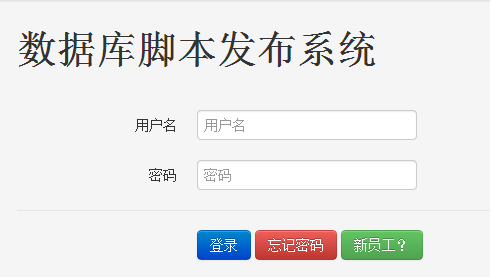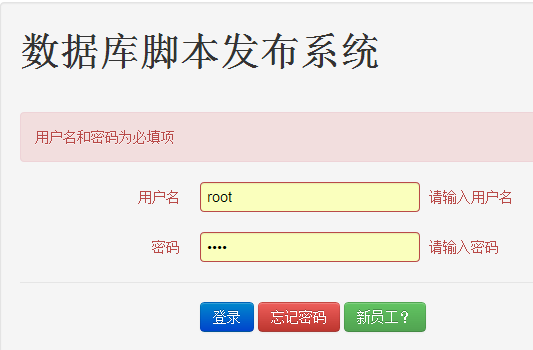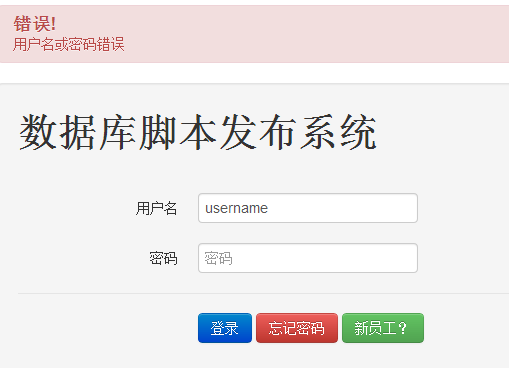Django实战之用户认证(用户登录与注销)
上一篇中,我们已经打开了Django自带的用户认证模块,并配置了数据库连接,创建了相应的表,本篇我们将在Django自带的用户认证的基础上,实现自己个性化的用户登录和注销模块。
首先,我们自己定义一个用户登录表单(forms.py):
from django import forms
from django.contrib.auth.models import User
from bootstrap_toolkit.widgets import BootstrapDateInput, BootstrapTextInput, BootstrapUneditableInput
class LoginForm(forms.Form):
username = forms.CharField(
required=True,
label=u"用户名",
error_messages={'required': '请输入用户名'},
widget=forms.TextInput(
attrs={
'placeholder':u"用户名",
}
),
)
password = forms.CharField(
required=True,
label=u"密码",
error_messages={'required': u'请输入密码'},
widget=forms.PasswordInput(
attrs={
'placeholder':u"密码",
}
),
)
def clean(self):
if not self.is_valid():
raise forms.ValidationError(u"用户名和密码为必填项")
else:
cleaned_data = super(LoginForm, self).clean()
我们定义的用户登录表单有两个域username和password,这两个域都为必填项。
接下来,我们定义用户登录视图(views.py),在该视图里实例化之前定义的用户登录表单
from django.shortcuts import render_to_response,render,get_object_or_404
from django.http import HttpResponse, HttpResponseRedirect
from django.contrib.auth.models import User
from django.contrib import auth
from django.contrib import messages
from django.template.context import RequestContext
from django.forms.formsets import formset_factory
from django.core.paginator import Paginator, PageNotAnInteger, EmptyPage
from bootstrap_toolkit.widgets import BootstrapUneditableInput
from django.contrib.auth.decorators import login_required
from .forms import LoginForm
def login(request):
if request.method == 'GET':
form = LoginForm()
return render_to_response('login.html', RequestContext(request, {'form': form,}))
else:
form = LoginForm(request.POST)
if form.is_valid():
username = request.POST.get('username', '')
password = request.POST.get('password', '')
user = auth.authenticate(username=username, password=password)
if user is not None and user.is_active:
auth.login(request, user)
return render_to_response('index.html', RequestContext(request))
else:
return render_to_response('login.html', RequestContext(request, {'form': form,'password_is_wrong':True}))
else:
return render_to_response('login.html', RequestContext(request, {'form': form,}))
该视图实例化了之前定义的LoginForm,它的主要业务逻辑是:
1. 判断必填项用户名和密码是否为空,如果为空,提示"用户名和密码为必填项”的错误信息
2. 判断用户名和密码是否正确,如果错误,提示“用户名或密码错误"的错误信息
3. 登陆成功后,进入主页(index.html)
其中,登录页面的模板(login.html)定义如下:
<!DOCTYPE html>
{% load bootstrap_toolkit %}
{% load url from future %}
<html lang="en">
<head>
<meta charset="utf-8">
<title>数据库脚本发布系统</title>
<meta name="description" content="">
<meta name="author" content="朱显杰">
{% bootstrap_stylesheet_tag %}
{% bootstrap_stylesheet_tag "responsive" %}
<style type="text/css">
body {
padding-top: 60px;
}
</style>
<!--[if lt IE 9]>
<script src="//html5shim.googlecode.com/svn/trunk/html5.js"></script>
<![endif]-->
<script src="//ajax.googleapis.com/ajax/libs/jquery/1.9.0/jquery.min.js"></script>
{% bootstrap_javascript_tag %}
{% block extra_head %}{% endblock %}
</head>
<body>
{% if password_is_wrong %}
<div class="alert alert-error">
<button type="button" class="close" data-dismiss="alert">×</button>
<h4>错误!</h4>用户名或密码错误
</div>
{% endif %}
<div class="well">
<h1>数据库脚本发布系统</h1>
<p> </p>
<form class="form-horizontal" action="" method="post">
{% csrf_token %}
{{ form|as_bootstrap:"horizontal" }}
<p class="form-actions">
<input type="submit" value="登录" class="btn btn-primary">
<a href="/contactme/" rel="external nofollow" rel="external nofollow" ><input type="button" value="忘记密码" class="btn btn-danger"></a>
<a href="/contactme/" rel="external nofollow" rel="external nofollow" ><input type="button" value="新员工?" class="btn btn-success"></a>
</p>
</form>
</div>
</body>
</html>
最后还需要在urls.py里添加:
(r'^accounts/login/$', 'dbrelease_app.views.login'),
最终的效果如下:
1)当在浏览器里输入http://192.168.1.16:8000/accounts/login/,出现如下登陆界面:

2)当用户名或密码为空时,提示”用户名和密码为必填项",如下所示:

3)当用户名或密码错误时,提示“用户名或密码错误",如下所示:

4)如果用户名和密码都正确,进入主页(index.html)。
既然有login,当然要有logout,logout比较简单,直接调用Django自带用户认证系统的logout,然后返回登录界面,具体如下(views.py):
@login_required
def logout(request):
auth.logout(request)
return HttpResponseRedirect("/accounts/login/")
上面@login_required表示只有用户在登录的情况下才能调用该视图,否则将自动重定向至登录页面。
urls.py里添加:
(r'^accounts/logout/$', 'dbrelease_app.views.logout'),
以上就是本文的全部内容,希望对大家的学习有所帮助,也希望大家多多支持【听图阁-专注于Python设计】。